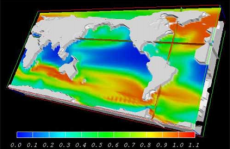Climate Model Developed on NERSC System Shows Faster CO2 Emissions Will Overwhelm Capacity of Land and Ocean to Absorb Carbon
August 1, 2004

The three-dimensional distribution of a hypothetical inert surface tracer through time demonstrates the pathways this tracer uses to go from the surface into the deeper ocean. The model was run for 50 simulated years; this frame shows the values of the passive tracer at the 11th vertical level.
One in a new generation of computer climate models that include the effects of Earth's carbon cycle indicates there are limits to the planet's ability to absorb increased emissions of carbon dioxide.
If current production of carbon from fossil fuels continues unabated, by the end of the century the land and oceans will be less able to take up carbon than they are today, the model indicates, according to Inez Y. Fung, a professor at UC Berkeley, director of the Berkeley Atmospheric Sciences Center and NERSC user. She is also the lead author of a paper describing the climate model results that appeared in the Aug. 9, 2005 edition of the Proceedings of the National Academy of Sciences (PNAS). Fung developed the model on a NERSC supercomputer.
Fung was a member of the National Academy of Sciences panel on global climate change that issued a major report for President Bush in 2001 claiming, for the first time, that global warming exists and that humans are contributing to it.
"If we maintain our current course of fossil fuel emissions or accelerate our emissions, the land and oceans will not be able to slow the rise of carbon dioxide in the atmosphere the way they're doing now," said Fung. "It's all about rates. If the rate of fossil fuel emissions is too high, the carbon storage capacity of the land and oceans decreases and climate warming accelerates."
Currently, the land and oceans absorb about half of the carbon dioxide produced by human activity, most of it resulting from the burning of fossil fuels, Fung said. Some scientists have suggested that the land and oceans will continue to absorb more and more CO2 as fossil fuel emissions increase, making plants flourish and the oceans bloom. Fung's computer model, however, indicates that the "breathing biosphere" can absorb carbon only so fast. Beyond a certain point, the planet will not be able to keep up with carbon dioxide emissions.
"The reason is very simple," Fung said. "Plants are happy growing at a certain rate, and though they can accelerate to a certain extent with more CO2, the rate is limited by metabolic reactions in the plant, by water and nutrient availability, et cetera."
While the modeling runs cited in the paper were run at the National Center for Atmospheric Research in Colorado, Fung notes that the code was developed on NERSC’s Cray T3E supercomputer and cites NERSC in the paper.
A description of her research using NERSC can be found at <http://www.nersc.gov/news/annual_reports/annrep99/56sh_fung.html>.
About NERSC and Berkeley Lab
The National Energy Research Scientific Computing Center (NERSC) is a U.S. Department of Energy Office of Science User Facility that serves as the primary high performance computing center for scientific research sponsored by the Office of Science. Located at Lawrence Berkeley National Laboratory, NERSC serves almost 10,000 scientists at national laboratories and universities researching a wide range of problems in climate, fusion energy, materials science, physics, chemistry, computational biology, and other disciplines. Berkeley Lab is a DOE national laboratory located in Berkeley, California. It conducts unclassified scientific research and is managed by the University of California for the U.S. Department of Energy. »Learn more about computing sciences at Berkeley Lab.







